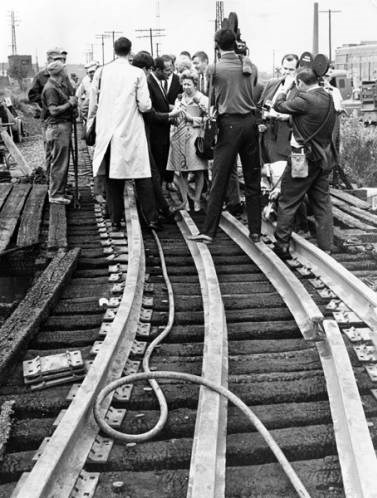Last updated: May 3, 2022
Article
The 1969 Cuyahoga River Fire

Cleveland State University Library/Cleveland Press Collection
Stories about the 1969 Cuyahoga River fire often combine fact and myth. People generally agree about what occurred on and immediately after June 22, 1969. Myth enters the stories when people describe the fire as a primary cause of major milestones in the environmental movement. Regardless, the Cuyahoga River fire has become a symbol of water pollution and the environmental movement. Today, we celebrate this symbolism, not just the facts of the story.
The fire took place in Cleveland, Ohio, a few miles north of Cuyahoga Valley National Park. Heavy industry dominates this section of the river. Railroad bridges near Republic Steel trapped debris in the river, causing it to pile up. Oil on the water added to its flammability. A flare tossed from an overpassing train likely provided the spark that ignited the debris. The fire lasted for less than a half hour and resulted in minor damage to the railroad bridges.
A Local Story Gains International Attention
The 1969 fire did not surprise Clevelanders. The river had burned more than 10 times over the previous century. The first newspaper coverage focused on the damage, not the fact that the river had burned. At the time, people largely saw the river a part of industrial infrastructure. In that light, a river fire seemed more normal. It is when we view a river as a natural system that a fire seems out of place.
Almost immediately, the narrative began to change. The fire took place on a Sunday. On Monday, June 23, Cleveland mayor Carl Stokes led local press on a pollution tour of the river. Betty Klaric, one of nation’s first full-time environmental reporters, covered the tour for the Cleveland Press. She had been writing about the Save Lake Erie Now campaign for several years. On August 1, Time magazine featured Mayor Stokes and the fire in a new section on “The Environment.” The article described the Cuyahoga as the river that “oozes rather than flows” and in which a person “does not drown but decays.” From there other national and international outlets picked up the story.
Remembering the Fire
The tide of public opinion about pollution changed in 1970. This led to the first Earth Day in April and the establishment of the Environmental Protection Agency in December. A flurry of environmental activism and legislation followed, including The Clean Water Act of 1972. Some say that the 1969 fire was the direct cause, but is that correct?
The real story is complex. Changes were already in motion. Nationally, the Water Pollution Control Act of 1965 had become law. Locally, Cleveland voters had passed a $100 million bond issue in 1968 for sewer construction and water treatment plant upgrades to protect Lake Erie. In 1969, the media paid more attention to a major oil spill in Santa Barbara, California. Months later, the river fire was yet another reminder of how bad things had become.
And yet the Santa Barbara spill is largely forgotten while the 1969 Cuyahoga River fire became world famous. It often appears in textbooks about the environmental movement. It was part of negative jokes about Cleveland that were popular in the 1970s. Today, “burning river” is used in the names of events, beers, and hot sauces.
As a symbol, the Cuyahoga River fire remains relevant. What does it mean to you?
